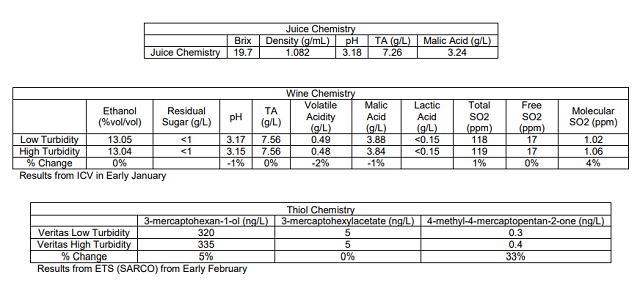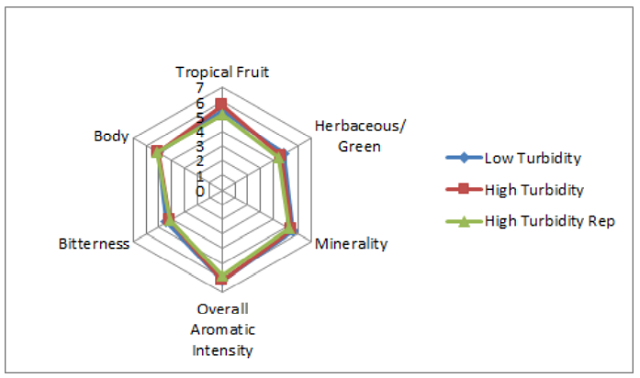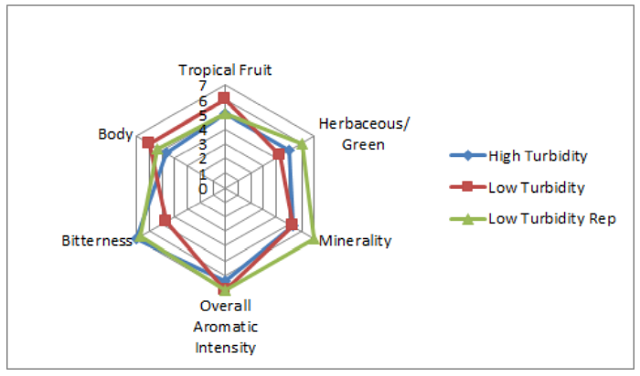The Effect of Juice Turbidity on Aroma Development in Aging Sauvignon Blanc (2017)
Emily Pelton
Veritas Vineyards and Winery
Summary
This study examines the impact of different turbidity levels in Sauvignon blanc juice on aroma development. Sauvignon blanc for this study was all harvested on the same day from the same block at Veritas. The grapes were destemmed and cold soaked at 45°F for 19 hours with 35ppm liquid sulfur dioxide and pressed the following day. Only free run juice was used. After the juice was pressed off Cinn-Free was added at a rate of 1.6ml/hL. The juice was settled for two days and then racked off of juice lees and inoculated with X-5 Yeast. At this point lees were added to two of the barrels to two levels of NTU (65.8 NTU and 195 NTU), while the third barrel kept the naturally occurring NTUs of processing (19 NTU). After fermentation the wine was allowed to settle and then was racked off of fermentation lees before barreling into three identical neutral barrels. At racking the medium and high rates of turbidity were combined, for two total treatments: 1) a low turbidity treatment and 2) a high turbidity treatment. No major differences in wine chemistry resulted from the turbidity differences. Thiol parameters may have slightly increased in the higher turbidity treatment. Overall, winemakers were able to distinguish statistically significant differences between wines (p<0.001). This may have been due to slight turbidity differences present in the glasses. No strong trends could be seen with the descriptors used in this study.
Introduction
Differing levels of juice turbidity from grape particulates is thought to help improve fermentation performance through yeast nucleation, toxin nucleation, and release of more nitrogen compounds. Sustained contact of grape particulates with juice results in greater extraction of grape aroma compounds and precursors. However, high turbidity juices often result in reductive qualities occurring during fermentation, which can lead to difficulties while preparing the finished wine. There is great potential, however, for the style of certain wines to be greatly impacted by the level of turbidity alone in juice. This study examines the impact of low and high juice turbidity on the chemistry and sensory characteristics of Sauvignon Blanc wine.
Results and Discussion
No major differences in wine chemistry resulted from the turbidity differences. Thiol parameters may have slightly increased in the higher turbidity treatment.

For the triangle test on January 31, of 31 people who answered, 20 people chose the correct wine (65%), showing a statistically significant difference between wines (p<0.001). These wines were voted to have an average degree difference of 4.55 (out of 10), suggesting that the wines were moderately different. Preference for each wine was split between the judges. There was a slight turbidity difference between these wines, suggesting that the triangle test results may have been skewed as a result. For the descriptive analysis on January 31, there were no strong trends for the descriptors used in this study.

For the March 14 tasting, the low turbidity wine had a slight tendency for higher Tropical Fruit, Minerality, and Body. There was a preference for the low turbidity wine. The wines were not found to be significantly different; however, there were very few judges present at this tasting, and so results are very weak.

Overall, winemakers were able to distinguish statistically significant differences between wines (p<0.001). This may have been due to slight turbidity differences present in the glasses. No strong trends could be seen with the descriptors used in this study. This study should be repeated in the future, with better controls for the tasting.
Methods
Sauvignon Blanc for this study was all harvested on the same day from the same block at Veritas. The grapes were destemmed and cold soaked at 45°F for 19 hours with 35ppm liquid sulfur dioxide and pressed the following day. The press cycle was the Champagne press program and the press fraction was kept separate. After the juice was pressed off Cinn-Free was added at a rate of 1.6ml/hL. The juice was settled for two days and then racked off of juice lees and inoculated with 20g/hL of X-5 yeast rehydrated with Fermo Plus Energy Glu at 10g/hL. At this point lees were added to the barrels to two levels of NTU (65.8 NTU and 195 NTU), and then the control was the naturally occurring NTUs of processing (19 NTU). Nutrients were supplemented in doses throughout fermentation with 50 g/hL of Fermoplus DAP Free. After fermentation the wine was allowed to settle and then was racked off of fermentation lees before barreling into identical neutral barrels. At racking the medium and high rates of turbidity were combined so that only two treatments remained.
These wines were tasted on January 31 and on March 14. For the triangle test and preference analysis for the January 31 tasting, anybody who did not answer the form were removed from consideration for both triangle, degree of difference, and preference. Additionally, anybody who answered the triangle test incorrectly were removed from consideration for degree of difference and preference. Additionally, any data points for preference which did not make sense (such as a person ranking a wine and its replicate at most and least preferred, when they correctly guessed the odd wine) were removed.
In order to balance the data set to perform statistical analysis for descriptive analysis on the January 31 tasting, any judge who had not fully completed the descriptive analysis ratings were removed. In order to then make the number of judges between groups equivalent, one judge from group 1 was transferred to group 3. This resulted in a final data set of 3 groups, each with 10 judges (considered as replications within groups, and groups were considered as assessors). Data was analyzed using Panel Check V1.4.2. Because this is not a truly statistical set-up, any results which are found to be statistically significant (p<0.05) will be denoted as a “strong trend” or a “strong tendency,” as opposed to general trends or tendencies. The statistical significance here will ignore any other significant effects or interactions which may confound the results (such as a statistically significant interaction of Judge x Wine confounding a significant result from Wine alone). The descriptors used in this study were Tropical Fruit, Herbaceous/Green, Minerality, Overall Aromatic Intensity, Bitterness, and Body.
Due to the very small number of judges (3) at the March 14 tasting, only slight trends will be discussed for the sensory information.
